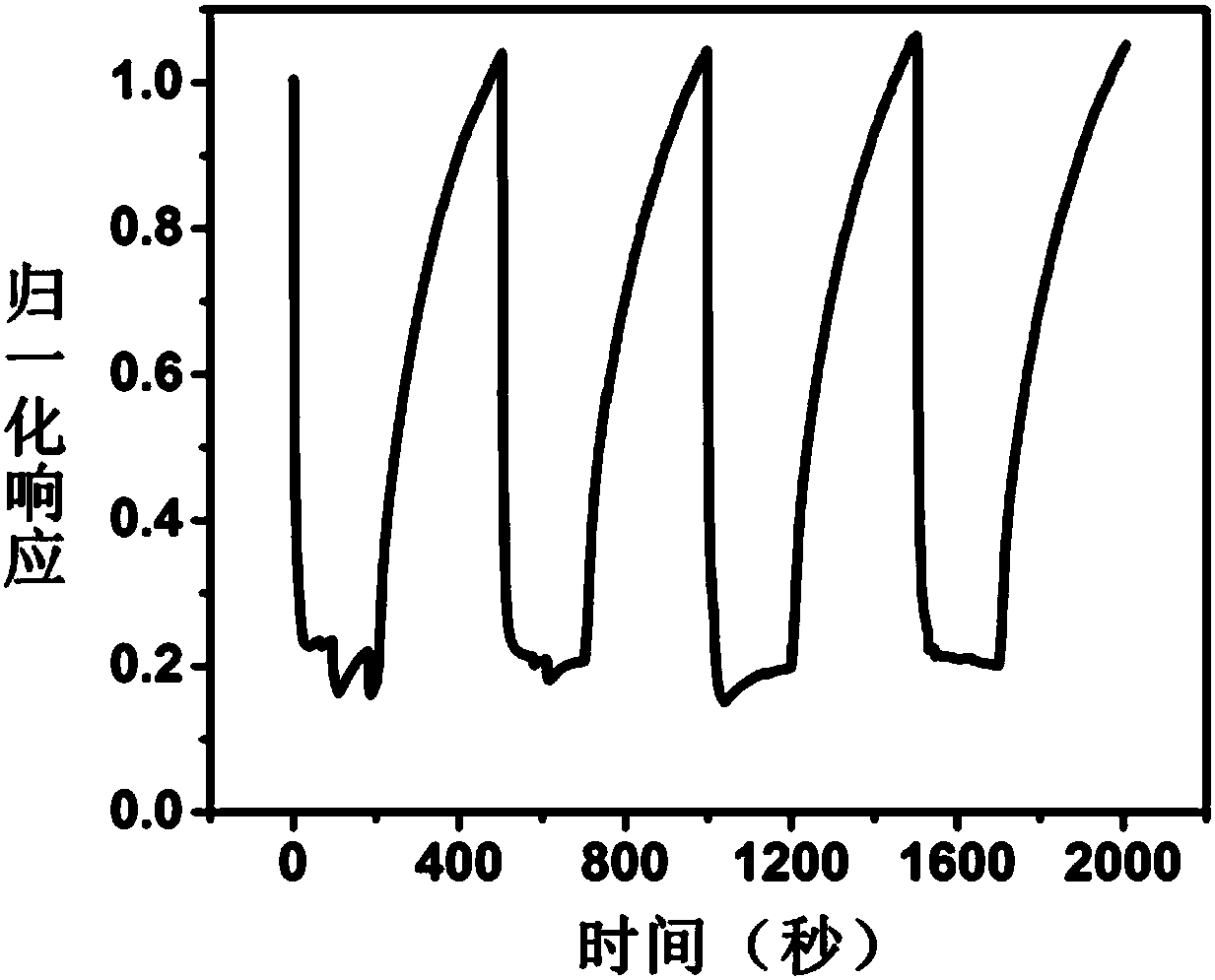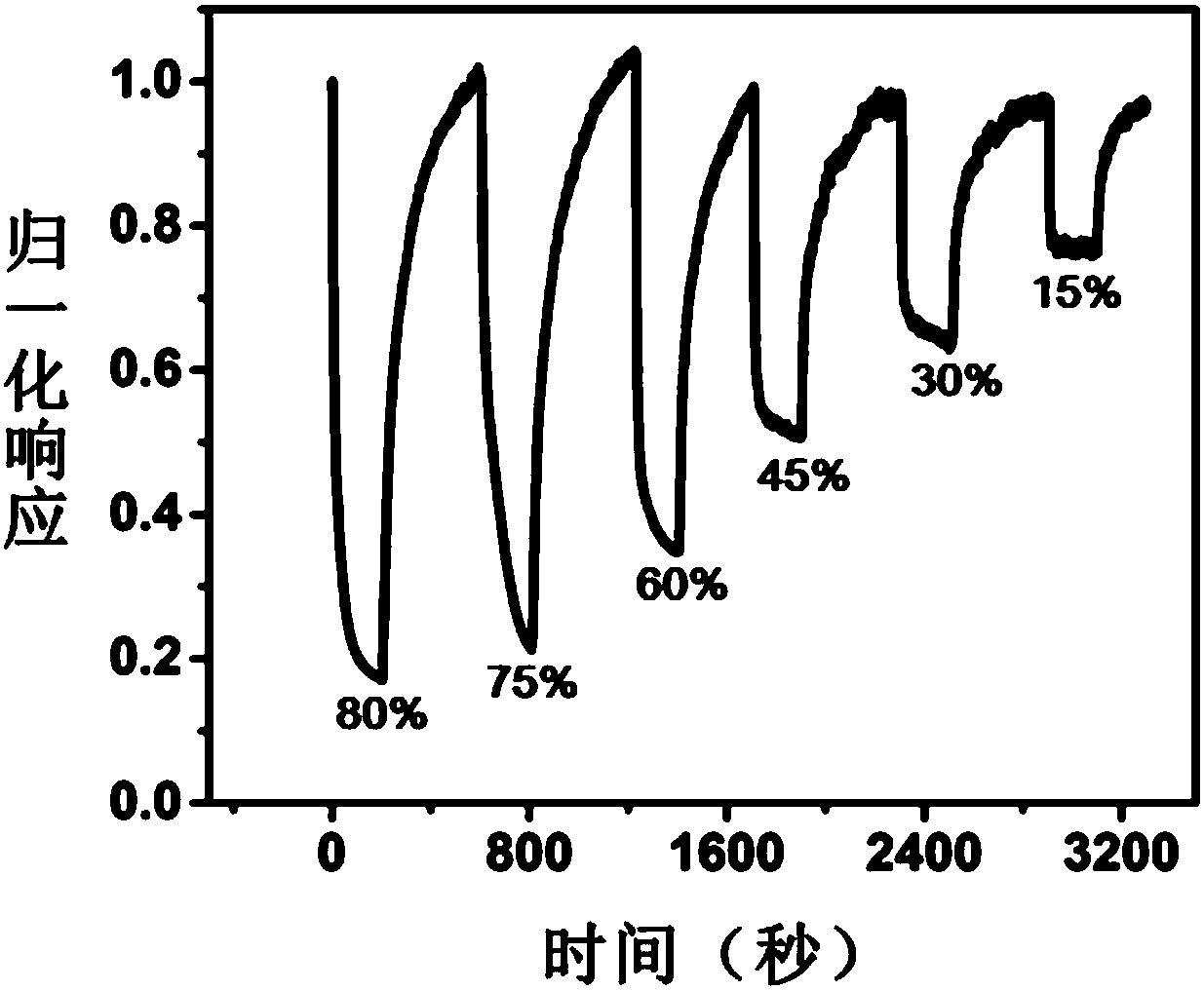Carbon dot-doped molybdenum disulfide sheet-based humidity sensor and preparation method thereof
A technology of humidity sensor and molybdenum disulfide, which is applied in the field of gas sensing, can solve the problems of long response time and low humidity response sensitivity, and achieve the effects of fast response speed, low price and excellent humidity response performance
- Summary
- Abstract
- Description
- Claims
- Application Information
AI Technical Summary
Problems solved by technology
Method used
Image
Examples
Embodiment 1
[0054] Example 1. Preparation of composites and humidity sensors based on carbon dot-doped molybdenum disulfide flakes
[0055] Step 1: Add 300 mg of L-glutamic acid into 30 mL of water, disperse evenly, transfer to a reaction kettle, heat at 200°C for 12 hours, and cool to obtain a carbon dot aqueous solution;
[0056] Step 2: Add 900 mg of sodium molybdate and 390 mg of thiourea to the 30 mL carbon dot aqueous solution obtained in the above step 1, disperse to obtain a uniform solution, and then transfer it to the reaction kettle. Heating at 200°C for 24 hours to obtain a crude solid compound based on carbon dots doped with molybdenum disulfide;
[0057] The solid crude product was alternately washed 3 times with deionized water and ethanol, and centrifuged at a centrifugation speed of 7000rpm for 10min to obtain a composite based on carbon dot-doped molybdenum disulfide flakes;
[0058] Step 3: Dissolve the compound based on carbon dot-doped molybdenum disulfide flakes obt...
Embodiment 2
[0060] Example 2, Preparation of composites and humidity sensors based on carbon dot-doped molybdenum disulfide flakes
[0061] Step 1, add 1200mg of L-glutamic acid into a round bottom flask, heat to 250°C until L-glutamic acid melts into a yellow-brown liquid, add 90mL of deionized water, dissolve and centrifuge to remove large particles to obtain carbon point water solution;
[0062] Step 2: Add 600 mg of sodium molybdate and 390 mg of thiourea to the 30 mL carbon dot aqueous solution obtained in the above step 1, disperse to obtain a uniform solution, and then transfer it to the reaction kettle. Heating at 160°C for 36 hours to obtain a solid crude product based on carbon dot-doped molybdenum disulfide composite;
[0063] The solid crude product was alternately washed three times with deionized water and ethanol, and centrifuged at a centrifugation speed of 5000 rpm for 30 min to obtain a composite based on carbon dot-doped molybdenum disulfide flakes.
[0064] Step 3: D...
Embodiment 3
[0065] Example 3, Preparation of composites and humidity sensors based on carbon dot-doped molybdenum disulfide flakes
[0066] Step 1: Add 300 mg of L-cysteine to 15 mL of water, disperse evenly, transfer to a microwave reaction bottle, and microwave at 200°C for 30 minutes to obtain an aqueous solution of carbon dots;
[0067] Step 2: Add 1200 mg of sodium molybdate and 390 mg of thiourea to the 30 mL carbon dot aqueous solution obtained in the above step 1, disperse to obtain a uniform solution, and then transfer it to the reaction kettle. Heating at 240°C for 12 hours to obtain a solid crude product based on carbon dot-doped molybdenum disulfide composite;
[0068] The solid crude product was alternately washed three times with deionized water and ethanol, and centrifuged at a centrifugation speed of 8000 rpm for 8 min to obtain a composite based on carbon dot-doped molybdenum disulfide flakes.
[0069] Step 3: Dissolve the compound based on carbon dot-doped molybdenum ...
PUM
 Login to View More
Login to View More Abstract
Description
Claims
Application Information
 Login to View More
Login to View More - R&D
- Intellectual Property
- Life Sciences
- Materials
- Tech Scout
- Unparalleled Data Quality
- Higher Quality Content
- 60% Fewer Hallucinations
Browse by: Latest US Patents, China's latest patents, Technical Efficacy Thesaurus, Application Domain, Technology Topic, Popular Technical Reports.
© 2025 PatSnap. All rights reserved.Legal|Privacy policy|Modern Slavery Act Transparency Statement|Sitemap|About US| Contact US: help@patsnap.com



